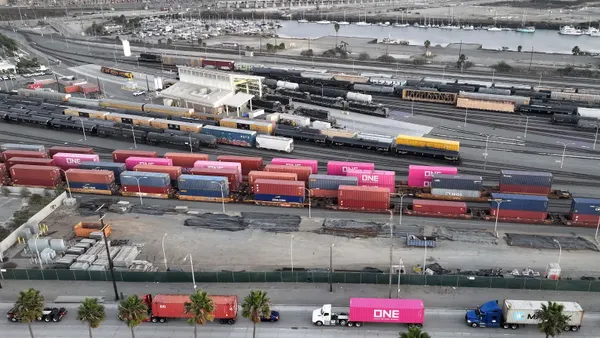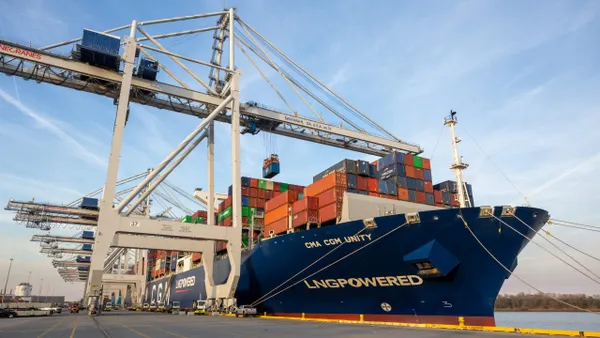Dive Brief:
- Hapag-Lloyd has reduced emissions per TEU-kilometer by 50%, and Maersk by 41.8%, from 2008 levels, beating the International Maritime Organization's (IMO) industry target of 40% emissions reduction by 2030, according to their respective 2019 sustainability reports.
- Hapag-Lloyd plans to reduce emissions by 20% (from 2016 levels) per TEU-kilometer in 2020 through the conversion of ships to low-sulfur fuels and investments in digital transformation efforts.
- Maersk reported it remains on track to achieve full decarbonization by 2050.
Dive Insight:
Before the coronavirus outbreak began, one of the foremost concerns in the maritime industry was meeting IMO 2020 compliance requirements by the Jan. 1 deadline. At the time, the cost of sourcing and switching vessels over to low-sulfur fuels was top of mind for shippers and carriers concerned about rising prices.
Since then, the COVID-19 outbreak has compounded costs and disruption. While Hapag-Lloyd has hinted at revenue difficulties to come later in 2020, Maersk has already suspended its earnings guidance for the year, citing coronavirus-related disruptions.
But some experts, including Dan Hubbell, shipping emissions campaign manager at the Ocean Conservancy, remain optimistic about the industry's ability to maintain progress on sustainability efforts. "There still seems to be every intention of keeping to the timelines envisioned in the [IMO] Initial Greenhouse Gas Strategy," he told Supply Chain Dive via email.
Studies show consumers favor environmentally friendly companies and shipping options. Forty-eight percent of consumers are more concerned about environmental sustainability and 55% are more likely to purchase environmentally friendly products as a result of the COVID-19 outbreak, according to a survey of 1,000 shoppers conducted by Kearney.
Ninety-five percent of Hapag-Lloyd's vessels now run on low-sulfur fuel, according to its report, producing 70% fewer emissions compared to when they ran on traditional crude. CEO Rolf Habben Jansen said the company "will continue to focus on additional improvements, including technological and digital innovations as well as further reductions in the emissions of our fleet."
The next step for the carrier is to transition from low-sulfur to LNG or biofuels, Jörg Erdmann, senior director of sustainability management at Hapag-Lloyd, told Supply Chain Dive via email. The company plans to convert one of its large container ships, "Sajir," to an LNG propulsion system in Q4 this year.
"LNG is a bridge technology as sustainable marine fuel for the midterm," he said. However, "In the long term perspective, we need to look further into alternative fuel solutions based on synthetic production ... biofuel as a drop-in is the fastest and much easier solution to kick-start sustainable marine fuel."
However, these investments require financial resources, in addition to cooperation with industry partners in order to bring sustainability innovations to scale in ocean shipping.
"Comparatively, the main challenge in decarbonising shipping is not at sea but on land," John Kornerup Bang, chief advisor for climate change at Maersk, said in its sustainability report. "The technological changes inside the vessels are minor compared to the massive innovative solutions and fuel transformation that must take place in the fuel supply chains to produce and distribute entirely new energy sources."
The creation of this infrastructure has been stymied in part by the COVID-19 outbreak and resulting disruption.
"Sustainability is a marathon rather than a 100-metre sprint. Given this fact, the issue will remain on our strategic agenda for the long term and be given high priority — also and especially in 2020, which has been an unusual year for all of us," Jansen said.














